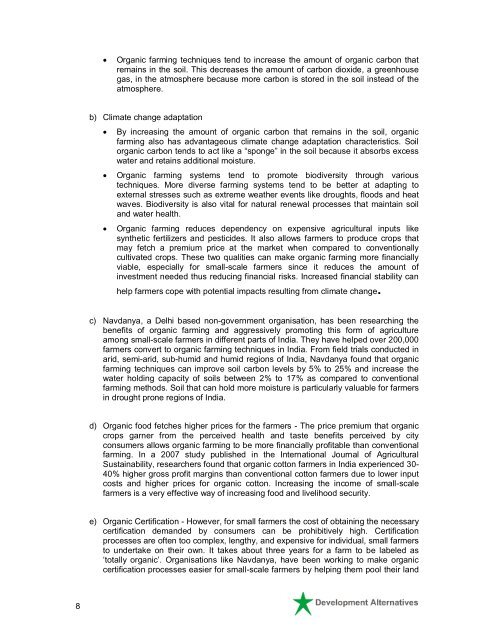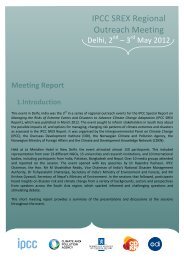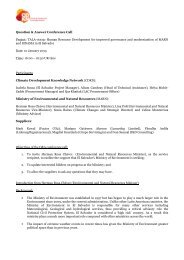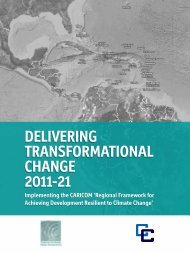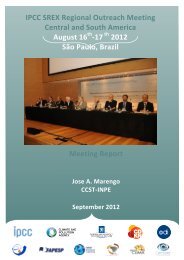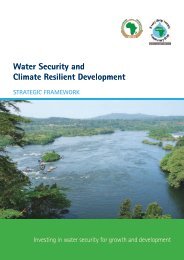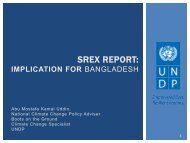Climate Change Guide for Community Radio ... - CDKN Global
Climate Change Guide for Community Radio ... - CDKN Global
Climate Change Guide for Community Radio ... - CDKN Global
You also want an ePaper? Increase the reach of your titles
YUMPU automatically turns print PDFs into web optimized ePapers that Google loves.
Organic farming techniques tend to increase the amount of organic carbon thatremains in the soil. This decreases the amount of carbon dioxide, a greenhousegas, in the atmosphere because more carbon is stored in the soil instead of theatmosphere.b) <strong>Climate</strong> change adaptationBy increasing the amount of organic carbon that remains in the soil, organicfarming also has advantageous climate change adaptation characteristics. Soilorganic carbon tends to act like a “sponge” in the soil because it absorbs excesswater and retains additional moisture.Organic farming systems tend to promote biodiversity through varioustechniques. More diverse farming systems tend to be better at adapting toexternal stresses such as extreme weather events like droughts, floods and heatwaves. Biodiversity is also vital <strong>for</strong> natural renewal processes that maintain soiland water health.Organic farming reduces dependency on expensive agricultural inputs likesynthetic fertilizers and pesticides. It also allows farmers to produce crops thatmay fetch a premium price at the market when compared to conventionallycultivated crops. These two qualities can make organic farming more financiallyviable, especially <strong>for</strong> small-scale farmers since it reduces the amount ofinvestment needed thus reducing financial risks. Increased financial stability canhelp farmers cope with potential impacts resulting from climate change.c) Navdanya, a Delhi based non-government organisation, has been researching thebenefits of organic farming and aggressively promoting this <strong>for</strong>m of agricultureamong small-scale farmers in different parts of India. They have helped over 200,000farmers convert to organic farming techniques in India. From field trials conducted inarid, semi-arid, sub-humid and humid regions of India, Navdanya found that organicfarming techniques can improve soil carbon levels by 5% to 25% and increase thewater holding capacity of soils between 2% to 17% as compared to conventionalfarming methods. Soil that can hold more moisture is particularly valuable <strong>for</strong> farmersin drought prone regions of India.d) Organic food fetches higher prices <strong>for</strong> the farmers - The price premium that organiccrops garner from the perceived health and taste benefits perceived by cityconsumers allows organic farming to be more financially profitable than conventionalfarming. In a 2007 study published in the International Journal of AgriculturalSustainability, researchers found that organic cotton farmers in India experienced 30-40% higher gross profit margins than conventional cotton farmers due to lower inputcosts and higher prices <strong>for</strong> organic cotton. Increasing the income of small-scalefarmers is a very effective way of increasing food and livelihood security.e) Organic Certification - However, <strong>for</strong> small farmers the cost of obtaining the necessarycertification demanded by consumers can be prohibitively high. Certificationprocesses are often too complex, lengthy, and expensive <strong>for</strong> individual, small farmersto undertake on their own. It takes about three years <strong>for</strong> a farm to be labeled as‘totally organic’. Organisations like Navdanya, have been working to make organiccertification processes easier <strong>for</strong> small-scale farmers by helping them pool their land8


